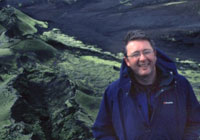Killer cloud

Dr John Gratan
18 January 2007
Killer cloud
On Friday 19 January the BBC's Timewatch programme (BBC2, 9.00 p.m.) will focus its attention on the eruption of Iceland's Laki fissure in 1783. The programme is based on research by Dr John Grattan from the Institute of Geography and Earth Sciences.
Article by David Keys which is published in the January edition of BBC History.
Killer cloud over UK
New research has revealed how a cloud of volcanic gas descended on Britain 223 years ago and killed 30,000 people – one of the worst natural disasters to hit Britain for many centuries. Up to 200,000 others died in France, the Low Countries and northern Italy.
The research was carried out by Dr John Grattan, senior lecturer at the Institute of Geography and Earth Sciences at the University of Wales, Aberystwyth. It suggests that in Britain climactic conditions associated with the event helped create increased levels of suffering which triggered major social reforms in factories and prisons. The gas cloud killed people by exacerbating their respiratory illnesses and the associated climatic conditions may indirectly have also contributed to an increase in typhus and other diseases that year.
The gas had originally been produced by a very large volcanic eruption in Iceland. Initially it was only Iceland’s population that suffered – around 25 percent of them died, many from volcanic fluoride poisoning. But a high pressure weather system over England and France meant that the gas and dust moved from Iceland across Scandinavia down into Germany and northern France and then into Britain. A volcanic mist settled over large areas of England.
With deaths mounting, the smell of sulphur in the air and huge volcanic-cloud-induced thunder storms, many began to fear that the end of the world was nigh, Dr Grattan’s research shows. Lightning strikes damaged many houses, and killed a number of people. The eruption went on for several months and in Britain and Europe up to 230,000 people died, most from hear and lung problems induced by the gas and fine dust from the cloud. The volcanic mist also raised temperatures and severely damaged vegetation, including crops. That winter, after the volcano had been spewing gas and dust into the atmosphere for several months, pollution began to reduce the amount of solar heat reaching the earth’s surface. Temperatures fell dramatically.
Dr Grattan’s research has revealed how the gas cloud catastrophe had a substantial religious impact. He has found instances where villagers forced their priests to exorcise the clouds because they believed that they came from hell. In many places prayers were held as people imagined that the last days were upon them. In England the membership of the Methodist church increased.
The hot climatic conditisions that summer seem also to have excerbated a typhys outbreak – and to have therefore contributed to the introduction of reforms in Britain’s prisons and factories. Typhus increased in apprentice houses attached to factories. In Lancashire, for example, 50 children died in one of theses houses attached to a cotton mill. There was public outcry by local residents who feared the disease might spread. Local magistrates commissioned a report which recommended strict regulation of factory conditions and suggested apprentices should be regularly bathed, magistrates in Glasgow and Yorkshire took similar action and when initiatives were seen to be working, pressure build up for legislation in Parliament.
Typhus also broke out in prisons, most notably in Gloucester where the sheriff ordered the construction of more spacious accommodation to reduce the risk of further outbreaks, Over subsequent decades many English counties followed Gloucester’s example.
“The events of 1783 reveal the complex links between natural disasters, disease patters and social reform,” said Dr Grattan.



